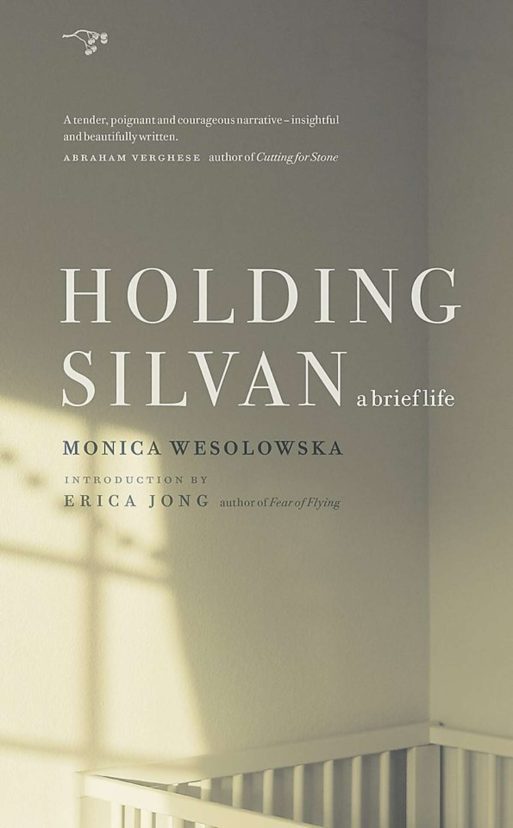 Few books offer a journey so intimate and overwhelming that we witness the author’s experience as though we were there. Intensely gripping, Holding Silvan, a Brief Life made me feel every second, every heartbeat from Monica Wesolowska’s true story—the infant loss of her first born.
Few books offer a journey so intimate and overwhelming that we witness the author’s experience as though we were there. Intensely gripping, Holding Silvan, a Brief Life made me feel every second, every heartbeat from Monica Wesolowska’s true story—the infant loss of her first born.
The author begins by describing the birth of her son, Silvan, who suffered from asphyxia. She informs us that there are four to nine million global cases of birth asphyxia each year—perfectly healthy babies that for some mysterious reason enter the world with severe brain damage. “‘It still happens, more than we’d like, but less often than it used to,’ says Dr. A to Monica and her husband, David.”
As Monica and David struggle through the thirty-eight long days of Silvan’s short life, Monica shares and teaches us so much. Prior to modern medicine, it would have been quite common for a family doctor to shuttle such an infant to a dark corner, where it would be left to starve to death. Parents were told “Your infant didn’t make it,” creating the impression that their baby was stillborn. Painfully honest, Monica openly considers how this cruel approach would have saved David and her from making difficult decisions on their unexpected journey of infant loss. Long and torturous, the journey involves giving birth to an unhealthly child, removing the breathing tube, deciding to not feed Silvan and, when he begins to suck, confronting an ethics committee to fight for the right to not feed him. Then they bring  him home with hospice and morphine palliative care. Finally, he dies. Monica hides none of her true thoughts or feelings. At first some are shocking and too real to read, but by the end of the book we come to realize how fearless she is.
him home with hospice and morphine palliative care. Finally, he dies. Monica hides none of her true thoughts or feelings. At first some are shocking and too real to read, but by the end of the book we come to realize how fearless she is.
As Monica leads us through her heartbreaking story, she relates it to her past experiences with death and always makes healing connections. I am personally heart struck by the number of deaths she has already gone through—her father, the suicide of her brother Mark and a close friend Maggy, who died of breast cancer. While these deaths do not make grief any easier for Monica, we witness how wise she has become in her decision-making process. She even chooses to let go of a friendship too shallow to bear.
Monica touches on many of the taboo themes around death and dying, drawing us openly and honestly into each. She and David discuss, consider and research every aspect of the process that Silvan’s birth has unexpectedly dealt them. Here are some examples.
How death today has radically changed:
“. . .in the twenty-first century, medicine has progressed to a point that most people in the United States no longer die of a disease. Instead, most people die of a choice to stop treating whatever diseases they have. Difficult as it is to choose death, every day people have to choose—for themselves, for parents, spouses, siblings, and even for children.”
How we are still not talking about death as she recalls a hospital visit from her friend Margie:
“‘Anyway, he might not even survive,’ I say now.
‘Would it be better for him to die on his own?’
‘How relieved I am that she is someone who can use that word die.’ How hard to use that word in conjunction with a baby. How wrong in a world where most babies survive. But I am beginning to suspect that he has been trying to do just that since the moment of his birth. To die. I nod.’”
The difficult decision to remove Silvan’s breathing tube:
“Dr. A begins to pull the long tube out. It’s unbearably long. I cannot look. But at last, he is free and there he is, my little Silvan. Just like that, he closes his mouth. He lifts his little hands up towards his face. One hand settles under his chin, the other cups his tape-reddened cheek. He breathes.
He breathes and seems to smile.”
Her struggle with her complex love of Silvan and his prospects of a life with brain damage:
“Desperate for him to stop breathing, I am in love with every breath he takes.”
The separate extremes of David’s and Monica’s grief when she throws herself to the ground and examines wild flowers while on a hike:
“If he worries that other hikers will come along and observe my freakish grief, he says nothing. But at the same time, he has temporarily run out of consolation. He seems almost to have run out of tears. He’s impatient now with my need to stop for every wave of grief.”
There is a great disparity between the care and genuine concern received from the doctors versus the nurses. When Monica and David decide to fight for the right not to feed Silvan their new unsupportive doctor suggests they meet with the ethics committee:
“‘You should not think of this as a battle. This is for you…’ Dr. A repeats in his soothing voice, and we are disappointed that even he has abandoned us. We cannot hear what he is saying. We suspect everyone of duplicity, we hear only platitudes.”
How supportive, honest and giving the nurses are surrounding her:
“For seventeen years on the floor, she never questioned her job. For seventeen years, she accepted that her job was to save lives until the day she tried working at an institution for children whose lives had been saved. She no longer believes it is in the best interest of all children to be saved.
‘They suffer,’ she says.
This is the refrain. ‘They suffer. They suffer.'”
More beautiful nurse support:
“Another nurse says, ‘I would do what you are doing for my own child.’
Another simply crouches at my feet, clasping my knees. ‘Let it out, let it out,’ she says as I sob.”
I cry and sob along with Monica. At times I felt my heart stop—my body paralyzed through her words. Holding Silvan is an amazing read, a gift from Monica for those who find themselves at the doorstep of an infant loss or stillborn birth. It is a virtual guiding light and a tremendous healing tool.
Monica is such a smart, brave girl. There is so much to say about this short book overflowing with emotion. I loved every page of it.
More healing posts on infant loss and stillborn birth:
- What is grief support for neonatal care? A San Francisco Bay area place where parents can find support after losing a child.
- The president and co-founder of Now I Lay Me Down to Sleep on the healing power of photography.
- Art guides parents and children through grief. “Dancing with midwives” expresses one woman’s grieving process after the loss of a child.

 “Holding Silvan, A Brief Life” by Monica Wesolowska
“Holding Silvan, A Brief Life” by Monica Wesolowska



 The Other Death in the Family
The Other Death in the Family















